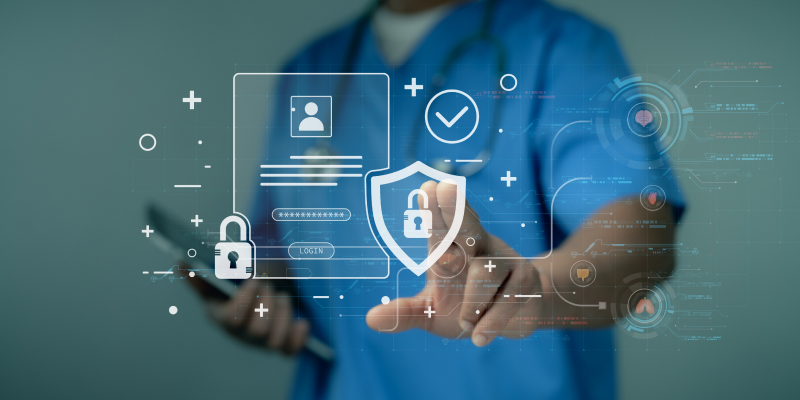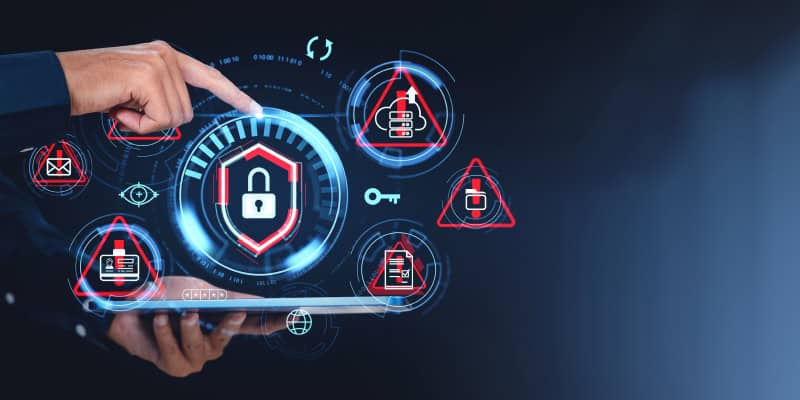Amid rapid digital transformation, information security in healthcare is paramount, as cyber threats targeting patient data continue to escalate. Thus, safeguarding patient data in this critical scenario requires a multi-pronged approach. This includes implementing:
- Robust firewalls
- Regular security audits
- Encryption of sensitive data
- Employee training
- Incident response plans
- AI tools usage for threat detection and mitigation
Fundamentally, cybersecurity services for healthcare aim to safeguard Protected Health Information (PHI) and sensitive patient data by securing third-party integrations and ensuring privacy, patient safety, and adherence to HIPAA regulations. This highlights the crucial role of network service providers.
This guide will help you understand the threats, security measures, and HIPAA compliance to build a culture that protects patient data from cybercriminals and prevents a medical data breach.
Identifying the Risks in Healthcare Patient Data Protection
It’s a common misconception that small clinics are safe from cybercriminals. The reality is that all healthcare providers face significant cyber threats daily, making healthcare patient data protection a critical priority. These threats include:
Ransomware Attacks
One of the most significant threats to healthcare is ransomware. This malicious software encrypts critical data, including Electronic Health Records (EHRs), rendering them inaccessible. Ransomware attacks can paralyze clinic operations as essential patient information becomes unavailable at the most crucial times.
Phishing Attacks
Cybercriminals deploying phishing attacks on hospitals use deceptive tactics, such as emails disguised as fake HIPAA checks, to trick staff into compromising PHI.
Impending Insider Threats
Insider threats also warrant attention. These risks can stem from both malicious intent and accidental actions by employees, who often have authorized access to sensitive data, posing a significant risk to overall healthcare data security protocols.
Outdated IT Infrastructure
Clinics operating with legacy systems—outdated technologies—often lack current security patches that are critical in securing patient medical records. This vulnerability creates easy entry points for cybercriminals. Internet of Medical Things (IoMT) devices should also be considered, as medical equipment connected to the network can introduce new vulnerabilities if not properly secured.
Therefore, understanding these multifaceted cyber threats is the first critical step in strengthening your patient data security in healthcare. Let’s explore how to build your defenses in the next section.
Also Read: How do you react when IT issues occur?
Fundamental Strategies to Ensure Information Security in Healthcare
So, how can healthcare organizations in Mesa improve their patient data security? Firstly, healthcare cybersecurity starts with practical foundations. Ensuring patient data security in healthcare requires deliberate attention to cost-effective, high-impact measures:
1. Implement Access Control Policies
- Role-Based Access Control (RBAC): Limit system permissions based on job responsibilities to prevent unauthorized viewing of sensitive records while meeting HIPAA’s minimum necessary requirements.
- Mandatory MFA Implementation: Require verification through secondary devices/apps to block credential-based attacks targeting patient portals.
- Proactive Password Protocols: Enforce 12-character minimums with mixed-case characters, numbers, and symbols—update passwords quarterly using managed vault solutions.
2. Be Consistent With Updates
- Patch Prioritization: Schedule weekly checks for operating systems and EHR platforms. Apply all security updates within 48 hours of release.
- Automated Protection: Enable auto-updates on connected medical devices and diagnostic equipment lacking IT oversight.
3. Encrypt Your Data
Data encryption for healthcare serves as your secret cipher against exposure. By scrambling records into unreadable formats, you protect data during storage and transfer from threats like ransomware and interception. Here’s what to do:
- Encryption at Rest: Ensure all stored patient data on devices (computers, servers, mobile devices, and storage media) is encrypted. Many operating systems and EHRs offer built-in encryption tools.
- Encryption in Transit: Encrypt patient data when it’s transmitted over networks, such as during telehealth consultations, an email exchange, or when transferring lab results. Utilize secure protocols like HTTPS for web traffic and consider VPNs for remote access.
4. Ensure Recoverable Operations
- 3-2-1 Backup Strategy: Implement regular, automated backups by maintaining 3 data copies across 2 storage mediums (like secure cloud storage and encrypted on-premise devices)—with 1 copy always offsite through encrypted channels. Test quarterly restoration workflows with guidance from reliable healthcare IT support.
Additionally:
- Hire reliable network service providers to establish a secure network architecture and ensure robust and safe Wi-Fi networks for patients and staff.
- Enforce WPA3 standards.
- Replace default IoMT device passwords regularly.
These measures strengthen cybersecurity for patient information in healthcare and lay the groundwork for compliance, a critical bridge to HIPAA mandates discussed next.
Exploring Compliance With HIPAA for Patient Data Security in Healthcare
Navigating HIPAA’s technical landscape often feels overwhelming—let’s simplify it. At its core, the “HIPAA Security Rule” exists to protect patient data via actionable measures. Dividing compliance into technical, administrative, and physical categories helps healthcare organizations manage compliance more effectively. This approach supports regulatory HIPAA compliance for healthcare businesses in Mesa and elsewhere:
Technical Safeguards Simplified
- Access Control: Assign unique user IDs and implement timed logoffs on all systems handling protected information.
- Audit Controls: Use built-in EHR reporting to track who accesses records—monitor weekly for anomalies.
Administrative Essentials
- Vulnerability Assessment: Use the HHS’ security risk assessment tool annually to identify vulnerabilities like exposed patient portal access points.
- Staff Education: Conduct quarterly mini-sessions covering phishing identification and secure data handling practices.
Physical Protections
- Screen Positioning and After-Hours Security: Position computer screens facing away from public areas and install automatic door locks for healthcare facilities after business hours.
- Device Security Checklist: Maintain a device checklist to ensure all workstations receive weekly security updates and USB port inspections.
Why prioritize these actions? Failing to address these basics can lead to significant breaches. Clear documentation of your written policies, including breach protocols and audit logs, is vital for proving compliance and protecting sensitive health information in healthcare.
While these measures are foundational, human vigilance is equally critical. Next, let’s explore how staff training strengthens these defenses.
Also Read: Building a Strong Cybersecurity Culture at Work: A Strategic Guide
Training Teams to Prevent Data Breaches in Healthcare
Beyond technical safeguards and administrative rules, the human factor plays a pivotal role in preventing healthcare data breaches and maintaining system robustness. Therefore, regular cybersecurity training for healthcare staff helps create a resilient security culture and ensures incident preparedness.
Indeed, healthcare staff serve as the first line of defense—yet human error remains a common contributor to costly data breaches. This highlights the importance of regular and ongoing staff education and training.
Effective programs boost cybersecurity awareness through essential topics like:
- Identifying phishing attempts and social engineering tactics
- Maintaining strong password protocols and secure EHR usage
- Following established procedures for reporting suspicious activities
To reinforce these lessons, consider phishing simulation drills that challenge staff to spot authentic-looking malicious emails in controlled scenarios. However, even with robust training, breaches can occur, making an incident response plan indispensable.
Protect Your Sensitive Healthcare Information
Proactive attention to patient data security in healthcare remains a daily commitment, directly safeguarding essential patient trust while protecting your practice’s reputation.
Remember: even modest clinics can make significant strides by implementing low-cost, high-impact security measures that solidify their security posture and enable the practice to thrive. Therefore:
- Prioritize an annual security review.
- Secure your network architecture.
- Embed data protection into your daily operations.
Ready to protect your healthcare facility from evolving cyber threats, including HIPAA patient data security in Mesa? At CMIT Solutions, Mesa, we offer robust business IT solutions that strengthen cybersecurity and foster patient trust. Contact us today for a comprehensive IT assessment!




